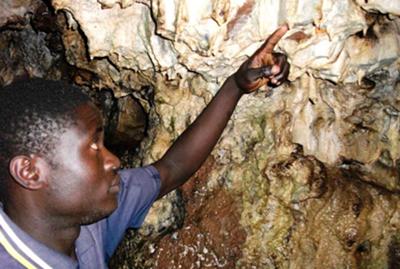VANILLA BEANS | SOYBEAN OIL | SOYMEAL & CAKE | COCOA BEANS | COFFEE BEANS
Breasts in a Uganda Cave: Amabeere Ga Nyinamwiru a Kabarole Tourist Site

Amabeere Ga Nyinamwiru in Kabarole Uganda
29-Feb-2012
When I came to work in Kabarole about two years ago, I was told of all sorts of stories about amabere ga nyina mwiru, the famous stalagmites and stalactites that look like cow breasts.
The amazing story about their oozing of milk made me long to visit the place and may be squeeze one like we squeeze cow udders in my homeland Ankole. These amazing features are approximately 10 kilometers away from Fort Portal town. At the site, I was given guides who took me down to the caves. The steaming sound of waterfalls and cold breeze at the entrance welcomed us.
Then a slippery path guided us through as we penetrated into a cool green world of moss and fern covered by trees and rocks. It is a sight of beauty, calm and awe.
“No, don’t touch these, you will affect their growth,” said one of the guides at the caves at Nyakasura falls.
“You see this milky stuff, it is calcium oozing through the rocks because of the water falls above us that rolls over the rocks forming these breast like rocks, the size keeps on growing with years until one arm touches the ground to make a strong pillar” explained the guide.
What the guide was talking about are the overhanging climbers intertwined with rocks that surround this cultural and eco-tourism site. Hanging rock pillars broken down by chemical reaction between water and salt in the course of years that form breast-like pointed small pillars from which the name Amabere comes from.
But to the locals, the name of the caves is based on a historical myth whose origin is widely believed by them that the breast-like pointed pillars were as a result of Bukuku’s beautiful daughter, Nyina Mwiru fleeing to this place in protest of her father’s refusal to allow her to marry a man of her choice.
Bukuku who was a very rich man served as a chief in the legendary Batembuzi dynasty that are the current Babiito kings of Tooro and Bunyoro kingdoms. “In anger and frustration, Nyina Mwiru decided to cut off her breasts at this spot,” says Apollo Musinguzi, the guide pointing to one of the rock basements.
Inside the caves, lies a huge flat cave roof basement dotted with water drops splashing as if rain is drizzling.
Geographically, these rocks and caves are called stalagmites and stalactites. Stalagmites may also refer to a type of fungus according to Wikipedia. A stalagmite is a type of speleothem that rises from the floor of a limestone cave due to the dripping of mineralised solutions and the deposition of calcium carbonate. The corresponding formation on the ceiling of a cave is known as a stalactite. If these formations grow together, the result is known as a column.
Stalagmite should normally not be touched: Since the rock build up is formed by minerals solidifying out of the water solution onto the old surface, skin oils can disturb where the mineral water will cling, thus affecting the growth of the formation. Oils and dirt from the hands can also stain the formation and change its colour permanently.
Similar structures can also form in lava tubes, known as lavacicles, although the mechanism of formation is very different. Stalactites and stalagmites can also form on concrete ceilings and floors, although they form much more rapidly there than in the natural cave environment.
The largest stalagmite in the world is 62.2 metres (220 feet) high and is located in the cave of Cueva San Martin Infierno, Cuba.
Their growth rates are so slow that once broken, they cannot recover during a human life span of time. Thus, stalactites and stalagmites are considered natural heritage objects and are protected by law in most countries, and their collection, mining, and selling is prohibited.
Indeed at Amabeere ga nyina mwiru, Yasamu Rubombora, the landlord of this site has preserved and conserved the place and its surroundings in his dairy farm with well-trained guides. As we were coming out of the caves, four minibuses were parked outside. They were carrying students of Mbarara High school. A look at the guest book shows how busy the centre is daily as tourists and students all over the world flock here each paying Shs5000 per head for local and double for foreigners.
At the site, there is Amabeere ga nyina mwiru guest house that charges Shs100, 000 per night for two bed rooms and breakfast. This is the only place in Uganda with such caves, natural with stalagmites and stalactites. It was listed among the top physical attractions in Kabarole District’s Tourism Development Plan of 2006.
By FELIX BASIIME : The Monitor Newspaper
If you haven't yet found what you were looking for or you need detailed information about the subject matter on this page then... feel free to ask our business travel consultants. |




